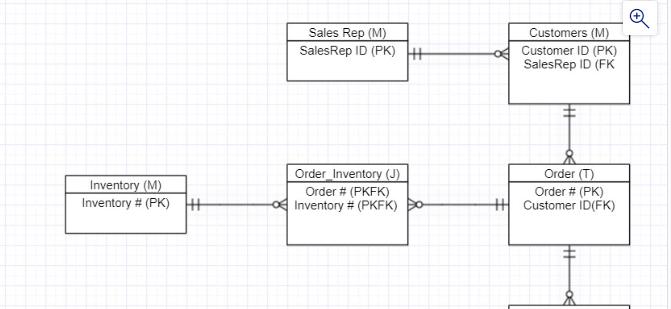Question
From the below determine the Master (M), Transaction (T), and Junction (J) tables involved (put M, T, or J after the name of the table).
From the below determine the Master (M), Transaction (T), and Junction (J) tables involved (put M, T, or J after the name of the table). Completed/Just Check it?
2. Using the flowcharting software of your choice (e.g., MS Visio, Lucid, SmartDraw, Gliffy, etc.), draw rectangles for each entity (table) in the ERD.
3. Label: a. Name of the table (no "correct" name...just reasonably descriptive)Completed/Just Check it?
b. Primary Key (PK) for each table, Completed/Just Check it?
c. Foreign Key(s) (FK) in each table, and Completed/Just Check it?
d. at least one other field in each table (use common sense...think about what non-key data fields would exist in each entity). Need Help
4. Connect the tables together to form an ERD using appropriate "crow feet" notation (as shown/discussed in class). Include associative entities where appropriate (i.e., junction tables to appropriately represent any many-to-many relationships). Make sure to label the maximum cardinality and minimum modality appropriately at both ends of the relationship.* Need help(I think i have sales rep to customer and then customer to order right but am having trouble figuring out the cardinalities for all the ones involving junction tables.)*(most important thing i need help with)
Narrative/Scenario:
At XYZ company, a sales rep can be assigned to more than one customer. The sales rep can be put into the ERP system before serving customers (hint: this part is referring to a minimum cardinality). A customer is assisted by one and only one sales rep, and must be assigned to a sales rep.
A customer can be put into the system before placing an order. A customer may place many orders, but a sales order comes from only one customer (i.e., customers do not share a sales order).
An order contains at least one inventory item but could contain many items. All items that XYZ keeps track of are not sold (some are used for maintenance of machines, etc.). An inventory item can be sold on more than one sales order.
Sales orders are later invoiced. Multiple sales orders can be on one invoice and there may also be partial billings (e.g., a sales order gets partially shipped and that shipment gets invoiced/billed, then the remaining portion of the sales order gets shipped and subsequently billed on another invoice).
The same applies to payments (for sake of this exercise, do not worry about payment type => assume all payments are the same type (e.g., check)). Customers can make a partial payment (remittance) on their invoice(s), pay an invoice in full, or a single payment can be made to apply to multiple invoices.


Inventory (M) Inventory # (PK) +H Sales Rep (M) SalesRep ID (PK) H Order Inventory (J) Order # (PKFK) Inventory # (PKFK) Customers (M) Customer ID (PK) SalesRep ID (FK Order (T) Order # (PK) HH Customer ID(FK) DO
Step by Step Solution
3.52 Rating (159 Votes )
There are 3 Steps involved in it
Step: 1
i A payment id in the payment table can be related to one invoice id from invoice tablea payment is ...
Get Instant Access to Expert-Tailored Solutions
See step-by-step solutions with expert insights and AI powered tools for academic success
Step: 2

Step: 3

Ace Your Homework with AI
Get the answers you need in no time with our AI-driven, step-by-step assistance
Get Started


